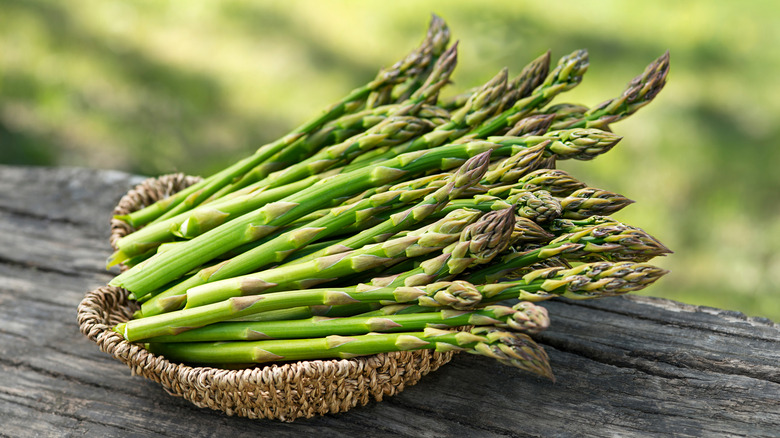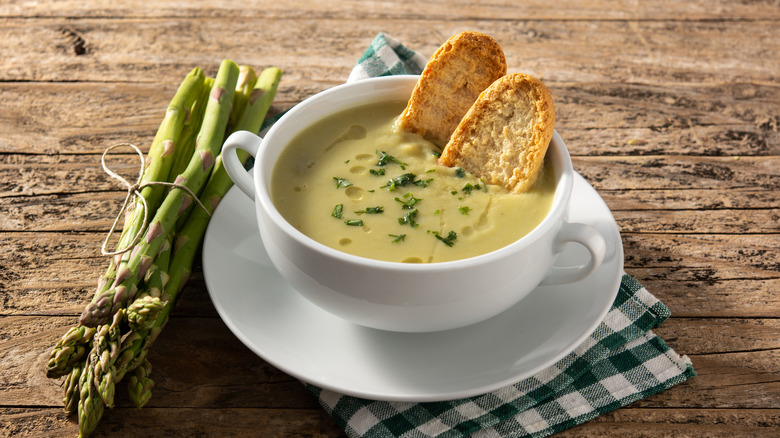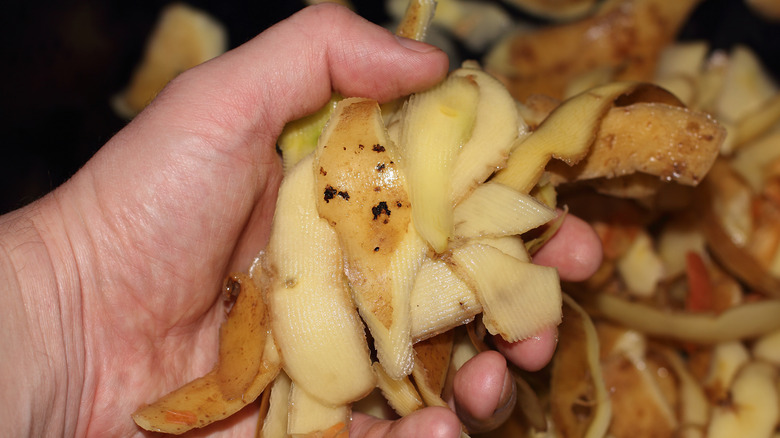The Best Way To Use Your Leftover Asparagus Ends
We may receive a commission on purchases made from links.
It's March, and even if your locale is still being blanketed with the white stuff, you can't deny that nature is practically vibrating with spring energy. The soil, though likely still cold and wet, is fresh and fecund, the air blowing in seems new, and you can almost hear the redbuds and dogwoods shaking free of winter's hold. As spring matures, so too does the early spring produce. Whether from a garden or from a just-opened farmstand, little is better — or more iconic — than asparagus. Roasted, grilled, blanched, in a tart, or smothered in chorizo and egg, asparagus is prized for its unique vegetal flavor and toothsome crunch.
One irksome element of the asparagus experience, though, is the waste that comes from the tough, woody ends of the purple-tinged green stalks. Despite a deceptive appearance not unlike the rest of the veggie, the wider end away from the spear-shaped head is ferociously fibrous.
But does this mean that roughly a third to half of your asparagus has to be chucked in the compost bin? The short answer is no.
Soup's on
As is so often the case with neglected bits in the kitchen, soup can be a savior, and a terrific example is this recipe from The Guardian. Chef Tom Hunt simmers the stumps with pungent leek greens, hearty spinach, and oats to extract flavor and nutrients and adds a dram of white wine to deepen the flavors before passing it all through a sieve, leaving the tough elements behind. Finished with a dollop of yogurt or a bit of cream, and you have a bowl of spring bounty to chase away the remnants of winter.
How then does one go about discerning where precisely the tender stalk ends? As pointed out in Food52, the common advice is to hold the tip of an asparagus spear in one hand and the tail in the other and very gently bend until there is a satisfying snap. That is roughly the line of demarcation. You then line up your other spears to the trimmed example, tip to tip, and slice through the remainder.
If you're really looking to maximize your asparagus haul, you can also try this tip from Martha Stewart Living. Rather than snapping her spears, Stewart trims off just the very end — where it looks dry — and uses a vegetable peeler to scrape away the thick skin of the widest portion and reveal the still tender heart. But don't throw out those peelings. You can use them to make — you guessed it — soup.
Trash to treasure
As spring gives way to summer and vegetable season kicks into high gear, cooks of all stripes find themselves dealing with more than just asparagus ends in the scrap heap. And even further beyond the world of vegetables, we are faced with all sorts of corners, drippings, and older items that fall short of the Platonic ideal, but are still capable of being quite good.
Thankfully, there is growing recognition of the need to reduce food waste, both for simple economy and as a means to increase the yield from our limited global resources. A 2021 compendium of recipes from The Spruce Eats lays out treatments for a variety of commonplace kitchen offal. Sweet potato peels and Brussels sprout leaves become crunchy chips, corn cobs thicken chowder broth, and bacon grease transforms into creamy gravy.
And lest you think boiling asparagus ends, candying citrus peels, and pickling watermelon rinds makes you a skinflint nonpareil, know that you are in good company. The esteemed Jacques Pepin, tempered by the frugal necessity of his upbringing in post-WWII France, literally wrote a book on the subject — "Cuisine Economique" — in 1992, telling the Baltimore Sun at the time, "Economy is implicit in any good chef. Not just the professional, but the home chef, too."


